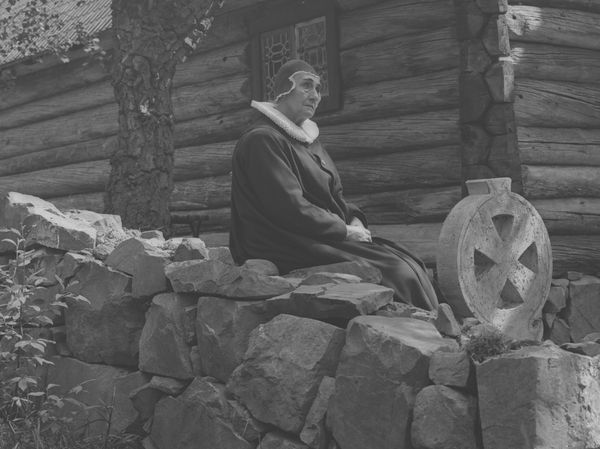PRÄSTÄNKAN
(The Parson’s Widow)
Carl Th. Dreyer (SE 1920)
Prästänkan is set in 17th-century Norway, then subject to the Danish crown; the University of Copenhagen held a monopoly on higher education. Three theological candidates compete for a ministry in a large village. Söfren, the most dynamic preacher of the three, needs the position to marry his sweetheart, Mari. He is offered the position, but only on condition that he marry his predecessor’s widow, the stern Margarete, who has already put three husbands in the grave. Mari moves in under the pretense of being Söfren’s sister, but Margarete repeatedly foils every attempt he makes to get Mari alone. One day he moves a ladder to trap Margarete in the attic, but instead Mari falls down and seriously injures herself. At her sickbed, the three of them come to understand each other better; they have all suffered because of the rules forcing people to marry to secure their livelihood, which mean that the happiness of some can come only at the cost of the death of others.
Throughout his career Dreyer spoke of his admiration for the Swedish silent cinema, and particularly Victor Sjöström, but with this film Dreyer himself made an outstanding contribution to the Swedish cinema. Prästänkan follows the model of adapting a literary work by a well-known writer, set in the past, and exploiting the backdrop of majestic Nordic landscapes, telling a story of characters who are not just heroes or villains but people struggling with difficult moral or psychological quandaries. Sjöström’s The Sons of Ingmar (Ingmarssönerna, 1919) was praised for its attention to folkloric detail, and Dreyer emphasizes ethnographic realism throughout his film. He shot the whole film in real 17th-century houses at Maihaugen, an open-air museum near Lillehammer, not just the exteriors but the interiors too, despite the considerable logistical difficulties this entailed. Some of the period props are foregrounded, like the pair of spoons connected with a chain that the bride and groom use at the wedding feast, but Dreyer’s zeal for authenticity extends to all aspects of the production. The extras with their luxurious beards were rural grandees from the area, recruited with the help of the poet Olav Aukrust, who was steeped in local language and tradition, and who appears in the film as one of Söfren’s competitors.
Much of the film is played as comedy – Aukrust’s sermon is so tedious that most of the congregation falls asleep, and the beadle must use a poke-stick to wake them up – but Dreyer keeps cutting to shots of Mari, whose quiet distress reminds us of the fundamental cruelty of the situation, the way the social order thwarts true love. While Greta Almroth (who played the title role in Sjöström’s Tösen från Stormyrtorpet/US: The Girl from the Marsh Croft, 1917) seems to play a largely passive role, her reactions are key to the film’s tone. Her anguish is not fully appreciated by Söfren, who comes across as a somewhat undependable, self-absorbed character. He is played by the Norwegian actor Einar Rød (Röd in the film’s credits, per Swedish orthography), who had appeared as the spiteful, cringing villain in John Brunius’s Synnöve Solbakken (A Norway Lass, 1919; shown in last year’s Giornate program). The stern and formidable widow is played with great intelligence and conviction by the 77-year old Swedish actress Hildur Carlberg, who was herself dying and passed away right after the end of production.
Shot by the Danish cinematographer George Schnéevoigt, who would later direct Laila (1929; shown at the Giornate in 2008) in Norway, the film’s images are meticulously composed. Throughout, Dreyer strives to tell the story visually, using a split-screen effect to convey a sound at one point. Shooting inside real houses made the placement of electric lights and the camera a challenge, and Dreyer does not respect screen direction. While the choice of shooting from different directions may have been imposed by the constraints of the buildings, he seems to have liked the effect. Because of the small number of characters, Dreyer was able to maintain spatial cohesion across shots, and in subsequent films he preferred to work in sets with four walls, allowing him to film his characters from all sides.
The character of Mari is called “Kari” in the Swedish and Danish programs for the film, as well as some other sources, but “Mari” is the spelling used both in Janson’s short story and the original title list.
About the restoration: An acetate duplicate negative derived from an acetate master made from the now–lost camera negative was scanned by the Swedish Film Institute in 2018. Full-length intertitles were re-created from an original text-list, with a design based on a handful of surviving flash-titles in the master. The color scheme with both tintings and tonings was also re-created from notes in the master.
Magnus Rosborn & Casper Tybjerg

regia/dir: Carl Th. Dreyer.
scen: Carl Th. Dreyer; dal racconto di/based on the short story by by Kristofer Janson, “Prestekonen” (1901).
photog: George Schnéevoigt.
cast: Hildur Carlberg (Margarete Pedersdotter, la vedova del pastore/the parson’s widow), Einar Rød (Söfren, aspirante pastore/theology candidate), Greta Almroth (Mari, la fidanzata di Söfren/Söfren’s fiancée), Olav Aukrust (aspirante pastore magro/skinny theology candidate), Kurt Welin (aspirante pastore grasso/fat theology candidate), Mathilde Nielsen (Gunvor, la domestica/maid), Emil Helsengreen (Steinar, il domestico/groom).
prod: AB Svensk Filmindustri.
uscita/rel: 04.10.1920.
copia/copy: DCP, 94′ (da/from 35mm, 1907 m. [orig. 1935 m.), 18 fps), col. (imbibito e virato/tinted and toned); did./titles: SWE.
fonte/source: Svenska Filminstitutet, Stockholm.


 Italiano
Italiano